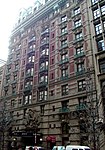Koreatown, Manhattan
Korean-American culture in New York CityKoreatowns in the United StatesMidtown ManhattanNeighborhoods in Manhattan

Koreatown (Korean: 맨해튼 코리아타운), or K-Town, is an ethnic Korean enclave in Midtown Manhattan, New York City, centered on 32nd Street between Madison Avenue and the intersection with Sixth Avenue and Broadway, which is known as Greeley Square. The neighborhood in Midtown South features over 150 businesses of various types and sizes, ranging from small restaurants and beauty salons to large branches of Korean banking conglomerates. Koreatown, Manhattan has become described as the "Korean Times Square" and has emerged as the international economic outpost for the Korean chaebol.
Excerpt from the Wikipedia article Koreatown, Manhattan (License: CC BY-SA 3.0, Authors, Images).Koreatown, Manhattan
West 31st Street, New York Manhattan
Geographical coordinates (GPS) Address Phone number Website Nearby Places Show on map
Geographical coordinates (GPS)
| Latitude | Longitude |
|---|---|
| N 40.747 ° | E -73.987 ° |
Address
Life Hotel
West 31st Street 19
10001 New York, Manhattan
New York, United States
Open on Google Maps





